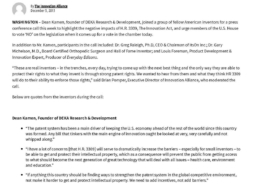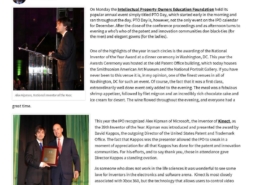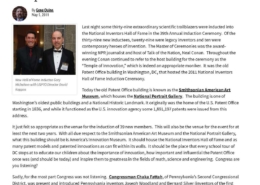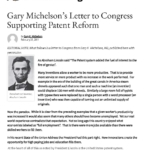A Conversation with Gary Michelson About Patent System Reform
April 1, 2010 | By Gene Quinn
Recently I had the opportunity to chat with Dr. Gary Michelson, an Orthopedic Surgeon and celebrated inventor who holds over 900 patents worldwide. Dr. Michelson acquired both fame and fortune as the result of his innovations, which were infringed by Medtronic, and who later settled with Dr. Michelson for $1.35 billion. As many readers know, Dr. Michelson recently sent a letter to Congress, specifically addressed to Senator Patrick Leahy (D-VT) and Congressman John Conyers (D-MI), who chair the Senate and House Committees responsible for moving forward with patent system reform efforts. Specifically, Dr. Michelson supports S. 515 and wanted to make sure that the Congress heard from an actual inventor who greatly benefited from the US patent system.

In my conversation with Dr. Michelson he explained to me that while he benefited greatly from the patent system he would have benefited even more if the system worked better. At this point Dr. Michelson “does not have a dog in the fight,” as he explained, because with the exception of a few lingering applications his patent portfolio has been fully acquired and he stands to gain no additional revenues. Nevertheless, Dr. Michelson, the quintessential successful American inventor, would like to see the US patent system improve for the benefit of all independent inventors, the American economy and to promote real job growth. He has some excellent ideas, I agree with his positions on almost every front, and it is with his approval that I put my conversation with him on the record.
I spoke with Dr. Michelson via telephone on Saturday, March 20, 2010, and again earlier today. We initially spoke for about 75 minutes, and then for close to an hour today. It is apparent that he has a unique take on the US patent system, being one of the few individuals to use each and every aspect of the patent system. In fact, Dr. Michelson has been involved in ex parte reexaminations, inter partes reexaminations, numerous federal lawsuits and appeals to the Court of Appeals for the Federal Circuit. So not only is he one of the most successful inventors of all time, but he has seen the good, the bad and the ugly in the US patent system up close and personal.
Our conversation started out with Dr. Michelson explaining that he has high regard for the US Patent and Trademark Office, but recognizing that “when the PTO fails to do its job well, the cost to society is enormous.” This immediately led to discussion of finding prior art, to which he said to me “even if the Patent Office has the best of intentions it doesn’t have the resources it needs.” In his letter to Congress Dr. Michelson specifically supported letting the Patent Office set its own fees and to be able to “reasonably budget for capital expenditures” required to sufficiently fulfill its critical role with respect to innovation. We also spent time talking about how fee diversion is nothing more than a tax on innovation. How else could you characterize taking fees paid by inventors and corporations to fund non-USPTO, general budget items?
Inadequate resources for the USPTO, innovation tax by diversion and inadequate archiving of prior art (which I have been very critical of myself) led to Dr. Michelson explaining that “any large corporation, particularly those with a global sales force can turn the world upside down and shake it until the prior art falls out.” As everyone knows, there is a difference between a patentability search, and the search that goes on during litigation when it matters and millions, or billions of dollars are on the line. As we went down this path, I explained my belief that it is fundamentally unfair that prior art that couldn’t have been found in any real or rational sense can be used many years later to invalidate patent claims. I posed the question — how is it fair to let inventors and businesses rely on granted patents, invest substantial sums of money and form businesses based on patent rights, only to have those rights pulled aer a no-stone-unturned search during litigation discovers prior art that was hardly known or findable in any real sense? Dr. Michelson seemed to agree, and what he was about to tell me would blow my socks off.
It is apparent that Dr. Michelson has given a lot of thought about how to reform the patent system, and his ideas will undoubtedly be viewed as radical by some, and brilliant by others. Count me in the brilliant column, but it is fair to say that I am a bit nervous about what he proposes. My fear is that Congress would pick some of his good ideas that would be viewed as minor tweaks to patent neophytes and leave the more extreme aspects undone. That could lead to disastrous consequences. Dr. Michelson agreed that “you are either in it or you are not, because there are some chasums that can only be leaped and not crossed in three small steps,” recognizing that his view of what patent prosecution could be is an all or nothing proposition. As we started to discuss his view of patent prosecution reform he told me that it is his view that a patent is “a contract between public good and the inventor,” and that there are four separate constituencies to be considered, namely inventors, competitors, the patent system and the public good, all of which would benefit by reform. In his words, “what we have now is severely broken and it is only going to get worse.”
Starting with the big picture first, Dr. Michelson explained that in his opinion Nathan Myhrvold, of Intellectual Ventures, is not promoting innovation. He candidly said that “trolling is not in the public good.” There will undoubtedly be some reading this that will fly into an apoplectic fit, because it is a widely held misconception that Dr. Michelson was the ultimate patent troll. Those who hold this belief are simply factually incorrect. The truth is that Dr. Michelson never once initiated any of the numerous federal lawsuits to which he was a party, each of them starting as the result of the alleged infringer bringing a Declaratory Judgment Action seeking a ruling of invalidity and/or non-infringement. So believe what you will, but truth is that Dr. Michelson is not and never was a patent troll. He was just an extremely successful inventor who had his patents infringed by those who found it more expedient to try and break him than deal with him.
In any event, building off the aforementioned trolling comment, Dr. Michelson explained that it is his view that patents should not provide the right to deprive the public good by allowing the owner of the patent to do nothing with it. In fact, he said that “anyone who does want to use an unused patent should be allowed to do so for a reasonable royalty as long as they are adequately providing benefit to the public.” So Dr. Michelson would embrace a form of compulsory licensing, which no doubt would be music to the ears of big-tech corporations everywhere. The caveat being that the patent owner must have a reasonable period of time to either provide the benefit of the invention to the public himself or license it to another to do so instead. So it seems pretty clear that Dr. Michelson’s compulsory licensing ideas would strike at the heart of true patent trolls, but not impact in any way, shape or form those who invent to exploit themselves through manufacture or licensing.
While Dr. Michelson believes “trolling is outrageous,” his view on willful infringement will certainly not earn him any friends in big-tech America. He believes that infringement “should be considered willful unless the defendant shows that it wasn’t.” In fact, Dr. Michelson recognized the crux of one of the reasons why I have been so reluctant to throw patent trolls under the bus, at least in a blanket fashion. With respect to so many patent infringement concepts, and particularly with respect to determining willfulness, the focus so frequently seems to be on the rights of and negative impact on the tortfeasor. This has always rubbed me the wrong way. There are no doubt bad actors; those that troll, holding up innovation and advancement, but in focusing on the patent troll alone there is a de-emphasis on the actions of the tortfeasor who is infringing a right granted and valid. Dr. Michelson’s approach to willfulness and compulsory licensing strikes me as the proper balance between alleged tortfeasor and alleged patent troll. It would have maximal impact on “true” patent trolls, without negatively impacting independent inventors, businesses who are forwarding innovation or Universities. It would also maximally impact those that carelessly, recklessly or wantonly disregard rights of others on which they tread.
As far as prosecution of patent applications is concerned, Dr. Michelson advocates conversion from “an ex parte process to an open and transparent process.” Under the Michelson vision of patent prosecution patent applications would be immediately published. Within the first 60 days the patent examiner would not work on the file whatsoever, and any member of the public would be allowed during this “objection period” to “weigh in why claims should not be allowed.” Those objecting could submit whatever prior art they want, but it would have to be summarized and specifically explain where in the references there is support for a valid rejection and why it should be provided. The first page, which would be a road map or index of sorts could be submitted without charge. Subsequent pages could include reasoning why the references apply and detailed explanation on what rejections would be appropriate and why. These explanation pages would have a cost associated with them, perhaps a $250 per page charge. This “fee for service” model is something that continued to come up over and over in our conversation, and is something I have advocated for a long time myself.
“Applicants should have the right to purchase from the Patent Office as much, or as little, legal service as desired with examiners credited commensurate with the work they provide.” Of course, this fee for service model would not only extend to the applicant, but to objectors as well. “Prior art could be submitted for free, but payment must be made for reading every page, and for every dollar or portion thereof the examiner should get credit.”
Dr. Michelson’s proposal would also allow for changes in the claims to be made by the applicant for no cost before the 60th day, and every time claims are changed thereaer an additional fee would be assessed. If I were to make a friendly amendment I would suggest that the applicant not be allowed to amend the claims until aer the close of the objection period. Then I would provide 3 months for the applicant to amend, thereby giving time to consider the prior art submitted along with the executive summaries and explanations. In true patent attorney fashion I would make the 3 months extendable to 6 months by further payment of extension fees. Dr. Michelson agreed that allowing for extensions is appropriate because it would allow those who want fast action to work quickly and diligently, while allowing those who need more time to slow things down and proceed more deliberately.
One thing that Dr. Michelson raised, and it was an excellent point, was how do you prevent an applicant from waiting for the objection period to be over and then making wholesale changes to the claims, rendering the objection submissions irrelevant? He answered his own question, obviously having thought about my suggestion, by saying anytime there is a broadening amendment or new claims that are broader than previously submitted, a new objection period would open. I like this idea myself because it would still allow for the addition of claims supported by the specification, but still giving the Patent Office the benefit of outside submissions.
According to Dr. Michelson, one of the key benefits of an objection period would be that it would allow the Patent Office to keep initial filing fees low, perhaps extremely low. Because the first review is done by those in industry or otherwise interested, there is no need to have more than just a processing fee at the time of filing. Then at the end of the objection period the applicant can decide whether it makes sense to move forward, or whether they should throw in the towel, thereby conserving resources for whatever invention might be next. Dr. Michelson credits Louis Foreman, executive producer of Everyday Edisons and the publisher of Inventors Digest magazine, for bringing this home. Foreman is a big fan of giving inventors realistic information as early as possible so they can appropriately evaluate the business realities of moving forward, which is something I think makes a lot of sense.
While I have always thought Commerce Secretary Gary Locke’s 10 month goal for a complete prosecution was unrealistic, if something like Dr. Michelson’s plan were adopted it could actually become feasible, or close to being feasible. Of course, patent examiners would have to cooperate, which would mean that there would need to be further revision of the newly created count system, and some examiners may need to be retrained and reconditioned to actually grant patents. Truthfully, I wish I had been consulted on the count system because while it is an excellent attempt, more credit should be given to the first application, absolutely no credit given for the first RCE, and some, but less credit given for subsequent RCE filings. If you make an examiner work for free for the second RCE that would really give them incentive to dispose of the case by finding the best prior art without nuisance Actions on the Merits, or allow the patent.
I like much of Dr. Michelson’s plan because it has a ring of speak now or forever hold your peace, which would tremendously benefit the patent system. It would assist competitors by giving them the opportunity to challenge what they feel they must, and it would allow for even greater certainty and settling of rights. This plan could almost obliterate the need for reexamination and for most invalidity challenges during litigation. Another friendly amendment I would offer is to not allow reexamination or invalidity to be argued based on any piece of prior art that was available and could have been found during the objection period. That would certainly settle the rights (as Director Kappos has said he wants to do) and at the very least force challengers not to sit back and then do a nostone- unturned search aer millions of dollars have been invested by the patent owner. Speak now or forever hold your peace. I like it. Of course, if we really have a speak now or forever hold your peace objection period, or even speak now or sort of hold your peace objection period (by making it even more difficult to demonstrate invalidity later), the objection period might need to be longer than 60 days to give fair warning and time for consideration and action.
With respect to patent prosecution Dr. Michelson’s views are radical, extreme and brilliant, in my opinion. They are not constrained by any sense of doing things the way they are, or modifying what is already in place. I commented to him that his approach to the problem is that of an inventor, who sees a problem and seeks a solution, not constrained by known realities. Perhaps now is the time for a reinvention of the patent process and the patent laws. According to Dr. Michelson he would happily testify before Congress, and I suspect he could be persuaded to work with a committee to develop a better process. I know I would, and I suspect there are others who would as well.
So the ball is in Congress’ court now. patent system reformis pending, and while it could lead to efficiencies down the road and more funding for the USPTO immediately, I think it would be an enormous step forward for the legislation to authorize a top to bottom study of the US patent system in search of a better way to more directly rewards innovator and the public and settle rights so competitors have more certainty. Everyone wins, because like Dr. Michelson said “why would I want a claim that is invalid? That doesn’t help me. I want the broadest valid claim.”
Editorial Note: In order to keep this article of manageable length much of my discussion with Dr. Michelson is not reflected. I will be following up in the weeks to come with more from my discussion with Dr. Michelson.
References
- A Conversation with Gary Michelson About Patent Reform [2010.04.01. Gene Quinn. IP Watchdog]
- Patent Legislation Reform The America Invents Act Of 2011 | Michelson Patents


![[Pg1] Innovation Lessons From a Billionaire | IP Watchdog](https://www.michelsonmedicalpatents.org/wp-content/uploads/2016/06-08-ipwatchdog-innovation-lessons-from-billionaire/Innovation-Lessons-From-a-Billionaire-IPWatchdog.com-_-Patents-Patent-Law_Page_1-260x185.jpg)

 IP Watchdog
IP Watchdog IP Watchdog
IP Watchdog![[Pg 1] A Conversation with Gary Michelson About Patent Reform | IPWatchdog.com [Pg 1] A Conversation with Gary Michelson About Patent Reform | IPWatchdog.com](https://www.michelsonmedicalpatents.org/wp-content/uploads/2010/04-01-conversation-gary-michelson-patent-reform-ip-watchdog-gene-quinn/Pg-1-A-Conversation-with-Gary-Michelson-About-Patent-Reform-IPWatchdog.com-_-Patents-Patent-Law_IPWatchdog.jpg)
![[Pg 2] A Conversation with Gary Michelson About Patent Reform | IPWatchdog.com [Pg 2] A Conversation with Gary Michelson About Patent Reform | IPWatchdog.com](https://www.michelsonmedicalpatents.org/wp-content/uploads/2010/04-01-conversation-gary-michelson-patent-reform-ip-watchdog-gene-quinn/Pg-2-A-Conversation-with-Gary-Michelson-About-Patent-Reform-IPWatchdog.com-_-Patents-Patent-Law_IPWatchdog.jpg)
![[Pg 3] A Conversation with Gary Michelson About Patent Reform | IPWatchdog.com [Pg 3] A Conversation with Gary Michelson About Patent Reform | IPWatchdog.com](https://www.michelsonmedicalpatents.org/wp-content/uploads/2010/04-01-conversation-gary-michelson-patent-reform-ip-watchdog-gene-quinn/Pg-3-A-Conversation-with-Gary-Michelson-About-Patent-Reform-IPWatchdog.com-_-Patents-Patent-Law_IPWatchdog.jpg)
![[Pg 4] A Conversation with Gary Michelson About Patent Reform | IPWatchdog.com [Pg 4] A Conversation with Gary Michelson About Patent Reform | IPWatchdog.com](https://www.michelsonmedicalpatents.org/wp-content/uploads/2010/04-01-conversation-gary-michelson-patent-reform-ip-watchdog-gene-quinn/Pg-4-A-Conversation-with-Gary-Michelson-About-Patent-Reform-IPWatchdog.com-_-Patents-Patent-Law_IPWatchdog.jpg)
![[Pg. 1] IP Litigation A wards, Settlements Reach Record Highs Portfolio Media, New York (November 5, 2005)](https://www.michelsonmedicalpatents.org/wp-content/uploads/2005/11-05-ip-litigation-awards-settlements-reach-record-highs-portfolio-media/ip-litigation-awards-settlements-reach-record-high-portfolio-media_Page_1-150x150.jpg)
 IP Watchdog
IP Watchdog